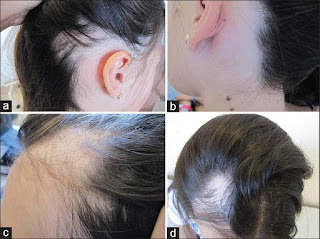A NEW DRUG TO REVERSE HAIR LOSS AND SKIN DAMAGE LINKED TO FATTY DIET
Prof.Dr.Dram,profdrram@gmail.com,Gastro Intestinal,Liver Hiv,Hepatitis and sex diseases expert 7838059592,9434143550
 In a series of experiments with mice, Johns Hopkins investigators have used an experimental compound to successfully reverse hair loss, hair whitening and skin inflammation linked by previous studies to human diets heavy in fat and cholesterol.The investigators say the compound halts the production of certain fats called glycosphingolipids, or GSLs, that are major components of skin and other cell membranes. Current research shows that mice fed a diet high in fat and cholesterol are more likely to have hair discoloration from black to gray to white, extensive hair loss and inflammation of skin exhibited by multiple wounds. Feeding these animals the compound, however, appears to reverse such symptoms.
In a series of experiments with mice, Johns Hopkins investigators have used an experimental compound to successfully reverse hair loss, hair whitening and skin inflammation linked by previous studies to human diets heavy in fat and cholesterol.The investigators say the compound halts the production of certain fats called glycosphingolipids, or GSLs, that are major components of skin and other cell membranes. Current research shows that mice fed a diet high in fat and cholesterol are more likely to have hair discoloration from black to gray to white, extensive hair loss and inflammation of skin exhibited by multiple wounds. Feeding these animals the compound, however, appears to reverse such symptoms.
More specifically, previous studies showed that GSLs are prevalent in the cells that make up the uppermost layer of the skin, as well as in cells called keratinocytes that help regulate pigmentation of the eyes, skin and hair.To determine how disrupting GSLs might affect skin appearance and color, and whether treatment with D-threo-1-phenyl-2-decanoylamino-3-morpholino-1-propanol (D-PDMP) -- a human-made compound that halts GSL production -- would reverse any negative effects, Chatterjee and his colleagues first genetically modified a group of mice to have atherosclerosis, a disease in which arteries are clogged by fat deposits.
The researchers then fed one group of these mice a Western diet high in fat and cholesterol, and a second group standard chow. All mice were fed their assigned diets from 12 weeks of age to 20 weeks.Compared to those fed standard chow, the mice that ate a Western diet lost hair, formed skin lesions and suffered from hair whitening. These results became more severe when the mice continued eating a Western diet for 36 weeks, with 75 percent of the mice having skin, hair loss and multiple skin lesions.
From 20 to 36 weeks of age, mice in both groups were given varying amounts of D-PDMP, either in a capsule or as a liquid, while they ate the same diet. Mice that received 1 milligram and 10 milligrams of D-PDMP in a capsule per kilogram of body weight from 20 to 36 weeks while eating a Western diet started regaining hair and hair color, and their skin inflammation lessened. Treatment with 1 milligram of D-PDMP in a capsule per kilogram of body weight was as effective as 10 milligrams per kilogram as a liquid. This suggests that an encapsulated form of D-PDMP is a better method of drug delivery.
The research team then looked at the skin of the mice's under a microscope and found that mice eating the Western diet experienced an infiltration of neutrophils, a type of white blood cell implicated in inflammation, in various skin areas. Treatment with D-PDMP in a capsule significantly reduced the number of neutrophils, implying reduced skin inflammation and wounding.
Next, the researchers used mass spectrometry analysis, a method of identifying and quantifying the chemical composition of a mixture, to determine ceramide, glucosylceramide and lactosylceramide levels in the mice. Ceramides are a type of lipid, or fat, that helps protect the skin's moisture, and glucosylceramide is the first derivative of ceramide, whereas lactosylceramide, a later derivative of ceramide, activates inflammation.
Compared to mice fed normal chow, those fed a Western diet had decreased total ceramide levels, decreased glucosylceramide and nearly three times more lactosylceramide. Treatment with 1 milligram of D-PDMP in a capsule per kilogram of body weight or 10 milligrams of D-PDMP as a liquid per kilogram of body weight, however, noticeably increased ceramide levels to normal.
- Kidney stones universally present hazard in north india,dillution by water prevent it
- Steroid and placebo effect equally for mild persisting asthma with low sputum eosinophils
- Government wants to fix public healthcare staff shortages with ayush docs: will it work?
- Plea in hc for payment of salaries of edmc, north mcd teachers and doctors
- 7 indian pharma companies named in us lawsuit over inflating generic drug prices
- Woman in up dies after explosion in her mouth during treatment,what is diagnosis?
- Woman in up dies after explosion in her mouth during treatment,what is diagnosis?
- Woman in up dies after explosion in her mouth during treatment,what is diagnosis?
- Air pollution ! mothers organising rally in london,anaesthetist choosing gas,will india follow?
- Cardiac arrest is always not sudden as understood -a study

 Comments (
Comments ( Category (
Category ( Views (
Views (